NET TRAP FOR CATCHING ANIMALS ALIVE
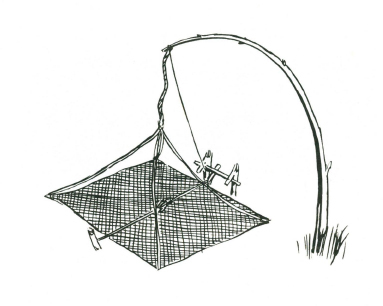
An alternative to the box type traps for catching animals alive and without injury can be devised by using many of the releases shown, in combination with the pull of a springy sapling. For purposes of demonstration in these pages one such arrangement is shown above. The net, of suitable size and strength, is spread on the ground and the centre is baited, as for any of the spring snares. When the release is effected the four corners of the net, being tied to the main rope holding down the sapling, are suddenly pulled upwards, enfolding the captured animal in the net without injuring it in any way. The animal in its struggles gets its legs through the mesh of the net, and so cannot climb out or tear the net to escape. It may chew its way out if the net is left unattended for any length of time.
USE OF A RAT TRAP OR A FISH-HOOK FOR DUCKS OR GEESE
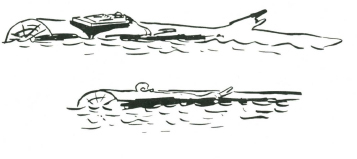
Select an area where, by the tracks and droppings, you know wild duck or geese feed. An ordinary rat trap, baited with a frog, and securely tied to a convenient log or stake is set either on a stone, or some place where it will lie flat and secure. The bird, in taking the bait, springs the trap, which cutting into its skull kills instantly. The fish-hook baited with a frog is tied to a stake by a short length of line. When the bird takes the bait it is hooked and held for killing. Alternatively, the cord from the fish-hook can be tied to a heavy stone, which, dislodged when the bird takes the bait, falls into the water and drowns the bird.
These two methods of catching wild birds are illegal in many countries, and are decidedly unsporting. They would be a legitimate method of getting game for food only in emergency. Another method frequently used by poachers for killing pheasants, pigeons and grain-eating birds is to soak split peas and then put thin wire through them, leaving about 1/8-inch of wire projecting from either side of the peas. The bird pick up the peas. The wire pierces their crops and they die quickly. This method is strictly illegal and destructive, and should never be used. You may find such ‘doctored’ peas or grain in an area and, if so, immediately inform the nearest game warden or ranger. Vandals who destroy bird life by such means as this are severely punished in most civilised countries.
BLIND ROLLER FOR AN AUTOMATIC FISHERMAN
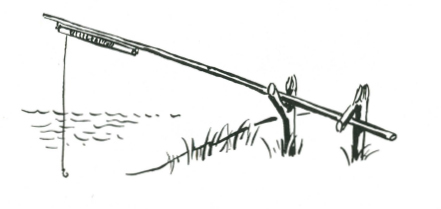
A discarded blind roller is fixed, with its bracket to either a pole or the convenient branch of a tree. The fishing line is secured to the roller, and then, with the roller pawl engaged, the line is pulled so that it touches the water, or until the tension on the line is considered to be adequate. The roller is removed from the brackets and rewound by hand. This will give tension to the line to play the fish. The baited hook is lowered into the water, making sure that the pawls are engaged. When the fish strikes it will disengage the pawls, and the tension of the wound-up roller will play the fish, finally bringing it almost to the surface of the water. The lazy fisherman simply has to unhook his catch, rebait the line and cast in for his second catch.
In general it is better to set the blind roller on to a pole which can be set horizontally above the water, and lashed to a convenient tree or stake, than to set the roller onto a branch. It is easier to remove the catch and reset, and also the pole with the roller blind can be moved to other locations.
FISH TRAP
ARROWHEAD TIDAL FISH TRAP SUITABLE FOR AREAS OF FOUR TO SIX FEET TIDES
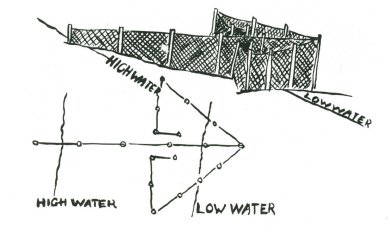
This is a permanent trap and will always ensure a plentiful supply of fish at all seasons. Select a site on an estuary or sheltered cove where the beach slopes fairly evenly. At this site run a fence of wire netting out at low tide so that the top of the fence will be a few inches above high water level, and the lower end will have a foot to eighteen inches of water at low tide. From the low water end of the fence run back two wing fences each at an angle of about forty-five degrees. These two wing fences should come halfway up to the high level water mark, and from the shore end of these two wing fences run two short fences parallel to the beach and stopping with a turnback to the arrowhead about two yards short of the centre fence.
The fish come in to the beach on the rising tide and feed swimming along the beach. They come to the central fence, and turn along it to the deep water, reach the corner at the deep water end and are turned by the wing fence, and again by the fence parallel to the beach. You can clear the trap at low tide, taking from it only those fish which you need. This trap has the advantage of only catching fish of good size, and not killing anything which may not be required for food. There will always be fish left in the pool at low water, and some of these are bound to find their way out to deep water at the next rise of the tide.
TIDAL ROCK POOL TRAP
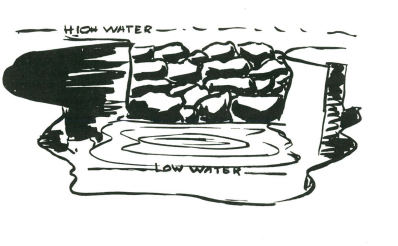
A site is selected where there are a number of rock pools well covered at high tide, and barely dry at low tide. One such rock pool is selected, and heavily baited with such food as crushed up shell fish, small portions of freshly killed fish, crushed up rock crabs and the like. Across the normal opening of the rock pool a wall of rocks is built so that the top of the wall will be a few inches below the water at high tide.
This should be done at a time when there is a low tide at dusk and dawn.
The fish, feeding at night on the rising tide, come to the rock pool, drawn there by the lures and baits lying on the bottom. With the fall of the tide they are trapped until the next full tide and if the rock pool you have selected is not too large at low tide you can easily collect your catch with a scoop net.
CRAB OR LOBSTER NET
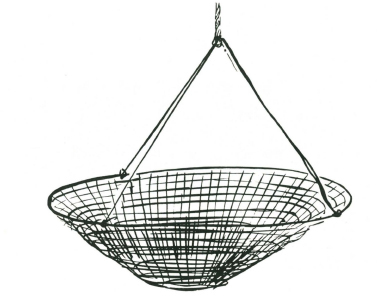
Make a circular wire hoop, three or four feet in diameter, and sew a piece of net or thin bagging around the edges so that there is a foot or so sag. To the wire hoop, tie three or four short lengths of rope, and join these together about three feet above the hoop. These cords from the hoop are tied to the hoisting rope, which can either be buoyed or tied to a convenient post or piece of rock, depending upon the location where the trap is being used. The bottom of the net is weighted with a piece of rock, and baited with a few fish-heads or portions of small fish. These must be securely tied to the bottom of the net.
The net is lowered into the sea, and left for about two hours. Pull it up swiftly, and any crabs or lobsters which have been feeding on the bait will be caught in the sag.
For lobsters, set the net on a rocky weedy bottom, or for crabs, on a sandy bottom, preferably not far from an underwater reef.
FISH TRAP
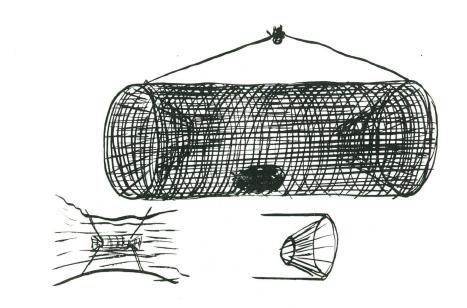
DRUM MET
A drummet is simply a wire cage with inverted cone shaped entrance at either end. These doors lead inwards and the fish swimming in through the cones are held securely inside the trap. A drummet can either be set in mid-stream, or dropped down into a deep pool of a nearby river, or set off a rocky ledge at the seaside.
A drummet must be baited to be effective, and almost any old bait will do, fish-heads, inedible varieties of fish, large shellfish or other bait will all attract fish to the feast.